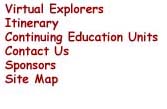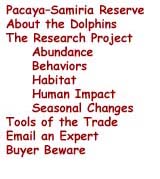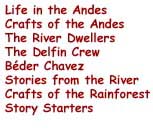

|
The Amazon River Dolphins website provides students and teachers with ample opportunities to engage in conversations and meaningful activities about complex mathematical and scientific concepts. Just as most people only learn a foreign language in an immersed setting, the Amazon River Dolphins website provides a meaningful and exciting context within which key mathematical and scientific concepts can be explored. In such a setting, students are able to gain a far deeper understanding of many of these key concepts. Content found on the Amazon River Dolphins website meets eleven out of thirteen of the National Council of the Teachers of Mathematics (NCTM) standards, fulfills the three underlying themes of the California Mathematics Framework, and meets and surpasses the requirements for the oceanography and life-science California Science Framework. A very special thank you to Gary Horne, math and science teacher at St. Theresa School in Oakland, California for providing this information.
National Council of Teachers of Mathematics (NCTM) The Amazon River Dolphins website utilizes the types of problems solving, conceptual based understanding and number visualization concepts stressed so often in the NCTM standards. Of the thirteen standards developed by the NCTM, the Amazon River Dolphins offers instruction directly in eleven and indirectly in the other two standards. Standard 1: Problem Solving This standard requires that schools teach students to use problem solving techniques to investigate situations, formulate problems based on observation, generalize solutions, and acquire confidence by using math meaningfully. The Amazon River Dolphins, by presenting students with data, and asking them to construct not only problems, "Why are the number of dolphins higher?", but also solutions "Because the pH is between such and such values." accomplishes this standard directly. Standard 2: Math as Communication NCTM requires that schools teach kids to model situations, reflect on the mathematics and then discuss ideas meaningfully. The Amazon River Dolphin meets this standard by communicating directly with students and asking them to respond in equally mathematical ways. Standard 3: Math as Reasoning This standard refers to students' abilities to recognize and apply deductive and inductive reasoning as well as making and evaluating math conjectures and arguments. When students look at environmental problems in numerical ways, they are both motivated to (by a common love of nature) and encouraged to look for solutions. Standard 4: Math Connections This standard asks schools to have students explore problems and describe results in graphical models. In the classroom, this is often accomplished with word problems that require diagrams. However, the Amazon River Dolphins website provides a more dynamic, meaningful, and "real world" way to meet this standard by having students graph the locations and numbers of Amazon wildlife and deduce future populations. Standard 5: Number and Number Relationships This standard simply requires students to represent numerical relationships in two dimensional graphs. By having students graph pH levels, for example, versus dolphin populations, this standard is met. However that is only one example of how the Amazon River Dolphins website can help teachers meet this standard. Daily, students will be presented with multitudes of opportunities to graph one set of data versus another. Perhaps students themselves will create graphs the researchers did not plan to make, and find previously unknown correlations. Standard 6: Number Systems and Number Theory This standard asks students to appreciate numbers beyond whole numbers and develop a use for ordered relations. By grade 6, all students are familiar with number representation as fractions and decimals. (By the start of grade 5, students understand how to order decimals.) Thus, as data is presented in whole, fractional, and decimal notation, students will get real-world practice in working with such numbers and placing them in proper order. Standard 7: Computation and Estimation NCTM requires that the middle grades focus on computation in proportion situations. A common proportion problem is to tag a known quantity of objects or organisms, release them into a large population, and then take a new sample. The new sample will have some tagged objects. The ratio of tagged objects in the new sample to the new sample size equals the ratio of total tagged objects to total population. This method, a common lesson in 6th, 7th and 8th grade math, is utilized by wildlife researchers almost daily. Standard 8: Patterns and Functions This standard asks schools to provide lessons where students describe, extend, analyze, and create a wide variety of patterns, tables, graphs, and rules. As students look at Amazon data over time, they will see the change in pH levels, saline count, temperature, and organism number. From such data, they can look for patterns, both numerical and graphical. Standard 9: Algebra For older students, the correlation graphs can be turned into algebraic functions. Creating functions and rules based on graphs is part of the 7th and 8th grade curriculum, and a requirement of the NCTM. By taking Amazon data, and creating algebraic functions, students have a way to predict future data. Standard 10: Statistics NCTM asks that students systematically collect, organize, and describe data. They should construct and read charts and graphs, and then make inferences and arguments. This is commonly accomplished by using data found in the appendix of the text book and graphing methods taught in a dry, artificial way. The Amazon River Dolphins offers the same curriculum but in meaningful, exciting ways. Standard 13: Measurement Finally, the NCTM has a requirement that schools teach students all systems of measurement. Students have a basic understanding of common units from their daily life. Metric measurements, and less common measurements are a part of the 5th through 8th curriculum. However, often teachers find that they must reteach them every year as they are never a part of students every day existence. The Amazon River Dolphins website offers students the chance to use the language of measurement in real ways and perhaps make them part of their life and more than just units in a book.
California Mathematics Framework The California Department of Education bases their framework upon NCTM's standards; however they have chosen three themes to unify the curriculum across the middle grades: Proportions, Multiple Relationships (graphs, charts, and coordinate systems), and Patterns and Generalizations. As described earlier, the Amazon River Dolphins website provides ample venues for teachers to expand on such topics as proportions (through sampling), relationships (through scatter plots, and charts), and patterns (by looking at data over time).
California Science Framework The California Science Framework is broken into three strands: Earth Science, Physical Science, and Life Science. California schools are required to teach topics in each strand every year ranging from simple definitions to complicated concepts. In general, the scientific aspects of the Amazon River Dolphins website far exceed the requirements of the framework which sets the goal of middle school science as introducing "students to the connection among the disciplines of physical, earth and life sciences" and to "establish the relevance of science lessons outside its content". Earth Science In the category of earth sciences, California Schools devote part of the 5th through 8th grade curricula on oceanography. This amounts to a discussion of the water cycle and should answer the question: How does water circulate in the ocean? This relates to a general concept of cycles which is reinforced every few years in the curriculum. Topics in oceanography contain: mapping the ocean floor, cold water currents, and erosion. Life Science The Life Science curriculum bears a closer resemblance to concepts found on the Amazon River Dolphins website. The framework defines the ecosystems component of Life Sciences as answering these questions: What are ecosystems? How do organisms interact in ecosystems? How does energy flow within an ecosystem? How do ecosystems change? What are the responsibilities of humans toward our ecosystem? Topics include populations, communities, species, predation, competition, niches, adaptations, habitats, and social groups. Clearly, the Amazon River Dolphins website covers all of these topics and in great depth. |




